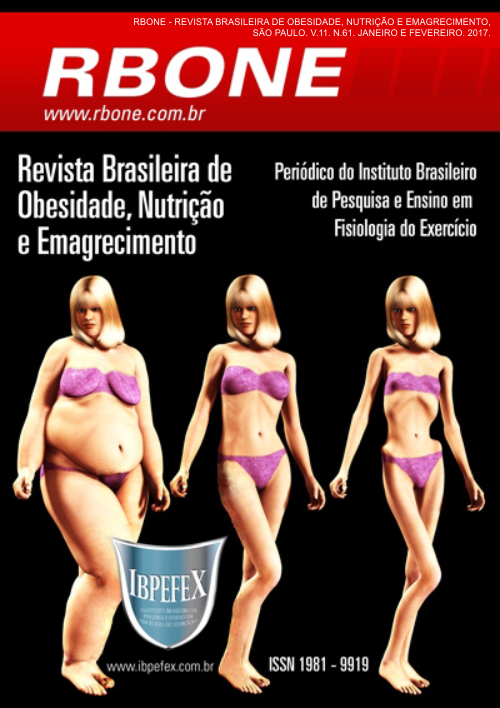Evaluation of the relevance of scientific articles on obesity and overweight in Feira de Santana 2003 and 2010
Abstract
Considering that overweight and obesity represent a reality in the global context, including location, which has fostered growth of scientific production on the said topic, this research undertook research on the importance of published articles on obesity and overweight in Feira de Santana 2003 to 2010. to this end, a literature search was performed to analyze the importance of production, taking into account the importance of organ and his publisher by the Web Qualis classification system used by the Coordination for Improvement of Higher Education Personnel (CAPES) to assess the importance of scientific production. After removal of articles on the Virtual Health Library (Rev and BDENf) using the terms obesity, overweight, Fair, Santana, we found that, of the four articles found, two (50%) fall into concepts considered less relevant for the scientific community, while the other two (50%) are classified as the most relevant.
References
-Batista, F. M. Rissin, A. A transição nutricional no Brasil: tendências regionais e temporais. Caderno Saúde Pública. Vol. 19. p. 191-1181. 2003.
-Batista, G. T. Abrangência Geográfica de periódicos científicos. Revista Ambiente e Água. Taubaté. Brasil. Vol. 2. Núm. 3. p. 12-18. 2007.
-Brasil. Ministério da Educação. Coordenação de pessoal de nível superior. Qualis CAPES 2008. Disponível em: . Acesso em: 27/09/2011.
-Demo, P. Educar pela pesquisa. 8ª edição. Campinas/SP. Autores Associados. 2007.
-Department of Health and Human Services. The surgeon general’s call to action to prevent and decrease overweight and obesity. [Rockville, MD]: Department of Health and Human Services, Public Health Service, Office of the Surgeon General. 2001.
-Diamond F. J. Newer aspects of the pathophysiology, evaluation, and management of obesity in childhood. Current Opinion in Pediatrics. Vol. 10. Núm. 4. p. 7-422. 1988.
-Escrivão, M. A. M. S.; e colaboradores. Obesidade exógena na infância e na adolescência. Rio de Janeiro, 2000. Disponível em: <http://www.jped.com.br/conteudo/00-76-S305/port_print.htm>. Acesso em: 24/09/2011.
-Garfield, E. Citation indexing. New York. John Wiley & Sons.1979.
-Gil, A C. Como Elaborar Projetos de Pesquisa. 4ª edição. Atlas. 2002. p. 44.
-Halpern, A. Obesidade. São Paulo. Lemos.1998.
-International Association for the Study of Obesity. 2011. Disponível em: <http://www.ioft.org/>. Acesso em:25/09/2011.
-Maia, R.T. A importância da disciplina de metodologia científica no desenvolvimento de produções acadêmicas de qualidade no nível superior. Revista Urutágua. Maringá. Núm. 14. 2008.
-Mancini, M. Métodos de Avaliação da obesidade e alguns dados epidemiológicos. 11ª ed. Revista Abeso. Disponível em: <http://www.abeso.org.br/pagina/194.shtml>. Acesso em: 25/09/2011.
-Mcardle, W. D.; e colaboradores. Fisiologia do Exercício: Energia, nutrição e desempenho humano. 5ªedição. Rio de Janeiro. Guanabara Koogan. 2003.
-Minayo, M.C.S. O Desafio do Conhecimento: pesquisa qualitativa em saúde. São Paulo: Ed. Hucitec. Rio de Janeiro: Ed. Abrasco.1999.
-Nieman, D.C. Exercício e Saúde: como se prevenir de doenças usando o exercício como seu medicamento. São Paulo: Manole, 1999.
-Packer, A. L.; Tardelli, A.O.; Castro, R. C. F. A distribuição do conhecimento científico público em informação, comunicação e informática em saúde indexado nas bases de dados MEDLINE e LILACS. Ciência Saúde Coletiva. Vol.12. Núm. 3. p. 587-599. 2007.
-Quadros, M. B. A importância da disciplina de Metodologia da Pesquisa Científica na Universidade. In: Anais –VII Congresso de Educação do Norte Pioneiro-Educação e Interdisciplinaridade. 2007. FAFIJA. Jacarezinho, 2007. p. 88-98.
-Ritto, C.; Soares, L. Pesquisa do IBGE confirma que obesidade é epidemia no Brasil. Disponível em: <http://www.veja.abril.com.br/noticia/saude/pesquisa-do-ibge-mostra-que-obesidade-e-epidemia-no-Brasil>. Acesso em: 25/09/2011.
-Rocha, E. M. O novo Qualis, ou a tragédia anunciada. Clinics. Vol. 64. Núm. 1. 2009.
-Rodrigues, P. C. Estudo sobre obesidade mórbida, produzido na UNB, mostra dados inéditos. 37ª edição. Revista da Abeso. Disponível em: <http://www.abeso.org.br/pagina/242/estudo-sobre-obesidade-morbida,-produzido-na-unb,-mostra-dados-ineditos.shtml>. Acesso em: 25/09/2011.
-Testa, J. A base de dados ISI e seu processo de seleção de revistas. Ciência da informação. Brasília. Vol. 27. Núm. 2. p. 233-235. 2001.
-WEBQUALIS. Disponível em: <http://www.capes.gov.br/avaliacao/qualis>. Acesso em: 30/09/2011.
-Wilmore, J. H.; Costill, D. L. Fisiologia do Esporte e do Exercício. 2ª edição. Manole. 2001.
-World Health Organization. Preventing and Managing the Global Epidemic: Report of a WHO Consultation on Obesity. Geneva. WHO. 1997. p. 17-36.
Authors who publish in this journal agree to the following terms:
- Authors retain the copyright and grant the journal the right of first publication, with work simultaneously licensed under the Creative Commons Attribution License BY-NC which allows the sharing of the work with acknowledgment of the authorship of the work and initial publication in this journal.
- Authors are authorized to enter into additional contracts separately for non-exclusive distribution of the version of the work published in this journal (eg, publishing in institutional repository or book chapter), with acknowledgment of authorship and initial publication in this journal.
- Authors are allowed and encouraged to post and distribute their work online (eg, in institutional repositories or on their personal page) at any point before or during the editorial process, as this can bring about productive change as well as increase impact and impact. citation of published work (See The Effect of Free Access).






